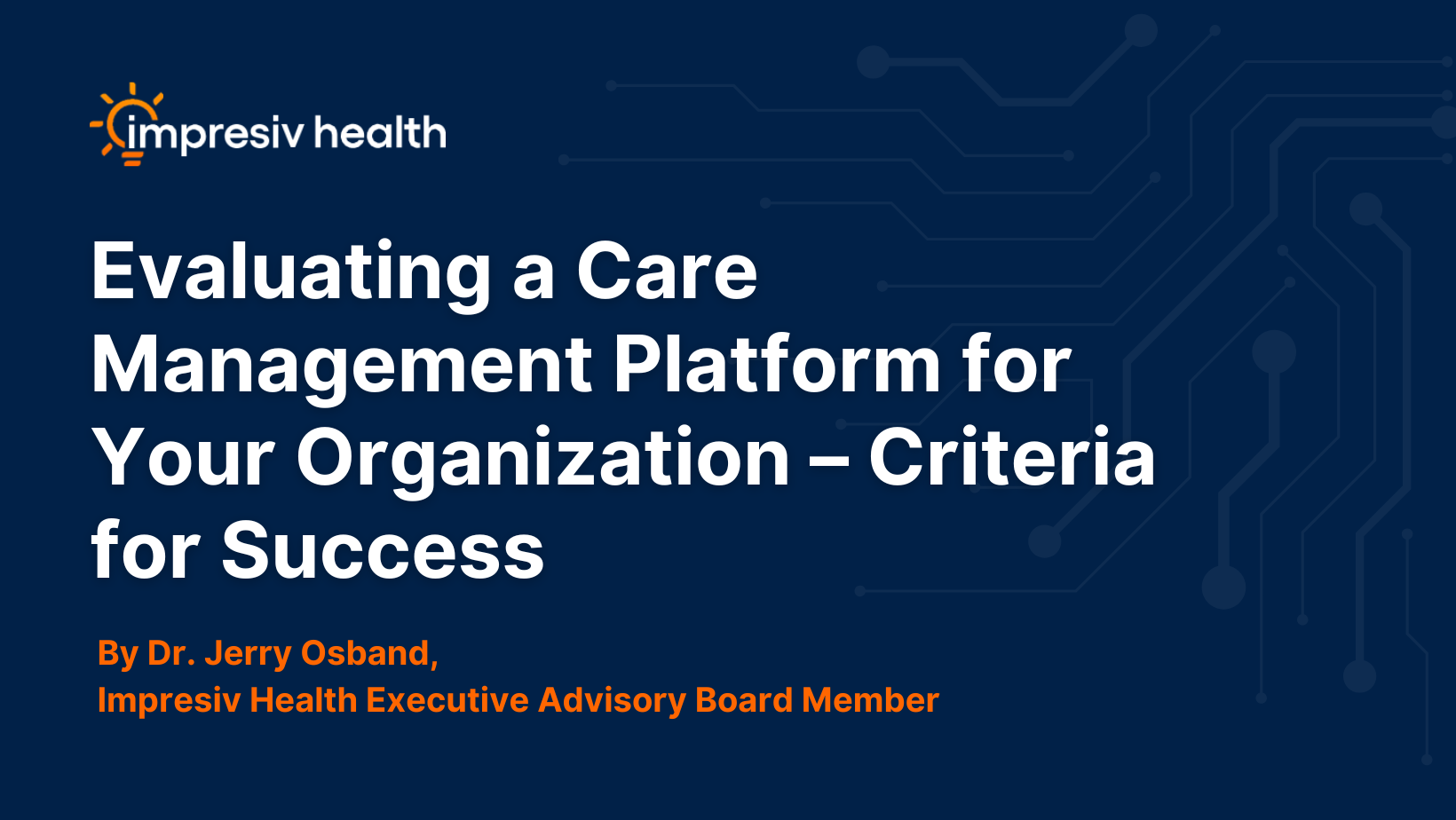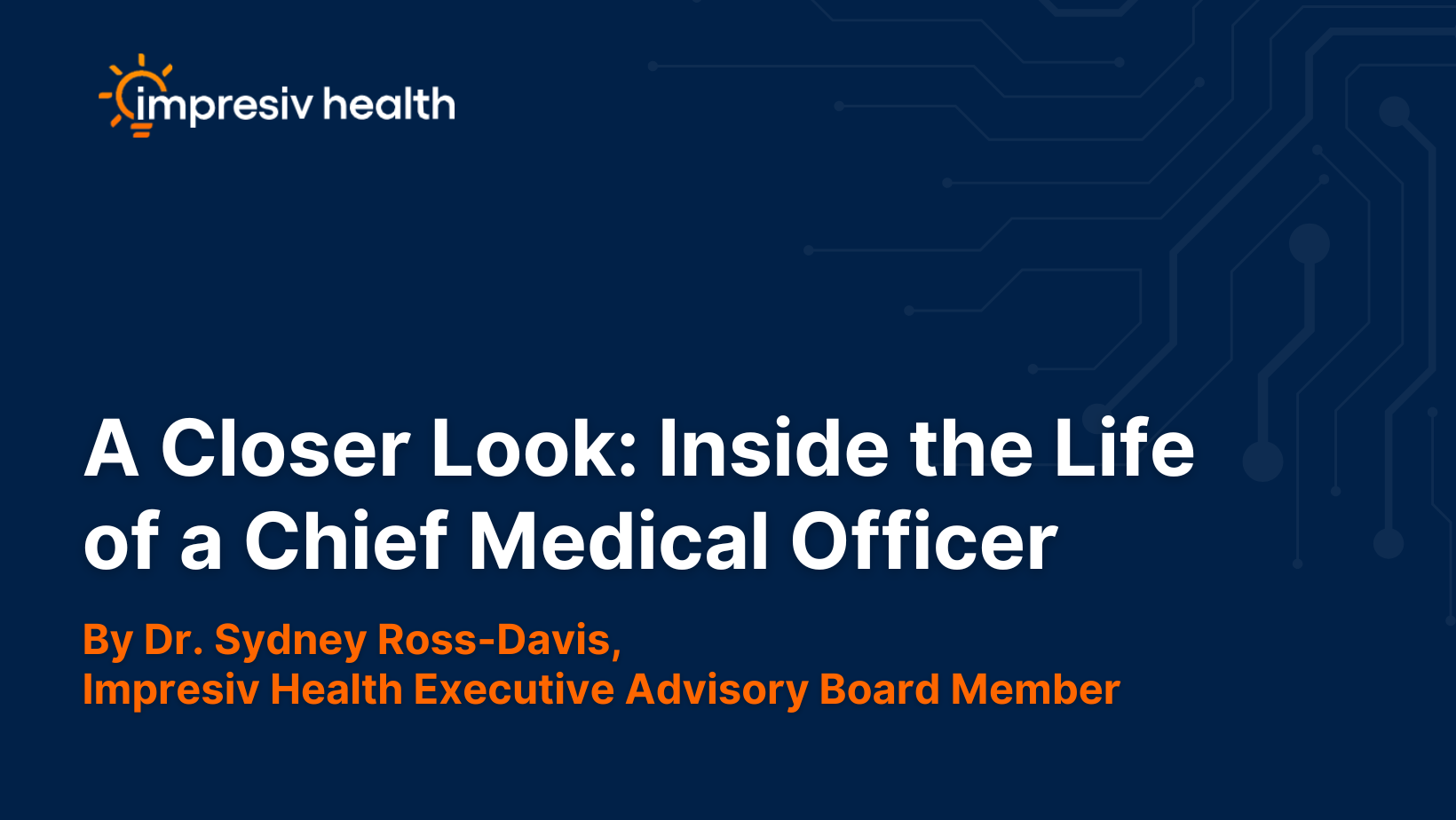
Evaluating a Care Management Platform for Your Organization – Criteria for Success
Shared by Dr. Jerry Osband, Former Chief Medical Officer for EXL and Member of the Impresiv Health Executive Advisory Board
Selecting, purchasing, and implementing a care management platform is a significant investment for any healthcare organization, requiring careful allocation of time, talent, and financial resources. As a cornerstone of IT and clinical operations, care management software plays a vital role in supporting utilization management (UM), case management (CM), and population health management. It also integrates key capabilities such as risk analysis, compliance tracking, audit functions, accreditation documentation, and quality reviews.
Beyond these core functions, the platform is a critical driver of organizational performance, enhancing productivity and enabling process automation to streamline operations. This article outlines the essential factors to consider when evaluating a care management software solution for your organization. It provides a comprehensive review of UM, CM, and population health management features, alongside analytics capabilities, to ensure the platform meets your functional and strategic needs.
Software Product Recommendations:
Utilization Management:
The system should offer highly automated intake and case setup processes for prospective, concurrent, and retrospective reviews. These case setups should support various functions, including inpatient and outpatient admissions, continued stay management, out-of-network policies and procedures, referral coordination, home care services, pharmacy needs, and durable medical equipment (DME) management.
Multiple types of outreaches should be included, such as phone, fax, digital, and portal. Automation not only applies to the intake and case setup but also to the approval, adverse determination, and appeals. Configurability is required to accept disparate rule sets to approve, deny, refer, and oversee the appeals of a case, as well as assess the benefit plan design.
All reasons for adverse determinations are clearly discernible, and templates for management of those cases are integrated. The software should include large “out of the box” rule set functionality to avoid costly configuration. Targets for automation can be identified in upfront policies and procedures reviews with the potential to have a vast majority of cases processed through the system without manual intervention.
Automation capabilities for evaluation may also address verification/eligibility assessments with minimal “clicks” and screen changes, provider tiering for expediting reviews, API for and/or incorporated clinical guidelines for rapid evaluation of medical benefit, automated letters/communications, and integrated compliance procedures.
The technology platform needs to include functionality for the upcoming FHIR requirements and integrate AI/MLR performance to provide continuous improvements and automation discovery through progressive enhancements of the product while in use. UM reporting capabilities are important in choosing a platform.
Automated dashboarding to assess caseloads, compliance, communications, letters, and productivity management is a key part of the UM technology. Aside from performance and productivity information, additional outputs for quality reporting, demonstrated accreditation alignments, inter-rater reliability, and overall platform performance and down/time.
Medical case management
As with UM, the platform should limit manual input for case initiation/setup and include automated screening tools to determine eligibility and value of CM; functionality should include intake through phone referrals, fax, digital, portal, and internally generated as an integrated 360-degree member view in the platform based on diagnosis/condition.
The system must demonstrate coordination and integration of services for performing UM within a CM case. Advanced risk assessment and HCC/RAF coding of cases are facilitated by having analytics embedded for identification/stratification of member risk and for improving reimbursements.
Enrollment/engagement into CM programs requires the platform to have fully integrated identification and stratification analytics in the care management platform and incorporate Outlook or a similar scheduling tool for provider appointments and follow-up calls. Risk scoring within the product should have a focus on impactability/readiness to change regarding reducing gaps in care. The scoring should incorporate disparate inputs from claims, lab, pharmacy, SDoH, self-reported assessments, EMR, wearables, portal, etc.
Automation includes multiple types of outreaches for phone, digital, cell, portal, wearable devices, with an API to third-party outreach firms for community services and programs. The reporting package requires customizable capabilities with limited configurable work and facilitates setups for KPIs and CM dashboards for screening results, risk assessments, engagement rates by condition, and case outcomes.
Performance and productivity reporting should have case volumes by severity and condition type, case completions, services provided, and alignment with accreditation standards and regulatory compliance.
Population Health Management (PHM)
Care management technology platform capabilities reflect the need for risk identification and management. Therefore, there is a need for embedded predictive analytics technology with AI, MLR, and NLP functions for managing input and real-time output of member and population analysis.
Data intake requirements include claims, pharmacy, lab, wearables, digital, self-reported, SDoH, Health Equity, and UM/CM care coordination outputs from within the system. The software needs alignment with governance oversight for security and compliance, and provides a 360-degree member view with integration into UM/CM cases.
Technology requires identification, stratification, and impactability outputs into a hierarchy of engagement and automatically facilitates the right communication methodology with scripting for the participant to address immediate enrollment in a program. Once enrolled, the system should also deliver educational materials and provider notification of enrollment.
Like case management, dashboards are an important part of the PHM required functionality. Reports need to be fully integrated and supply insights into performance and productivity, health status improvement and trends, engagement/enrollment rates, gaps in care closure, HEDIS/Stars impact and impact on HCC/RAF scoring.
Choosing the Right Care Management Platform
Selecting the right care management platform for your organization can be a complex task. At Impresiv Health, we bring years of consulting expertise, proven credibility, and a track record of cost-effective success in evaluating, selecting, and implementing care management platform solutions. Our team is here to guide you every step of the way, ensuring a seamless process tailored to your needs.
Get in touch with Dr. Gerald Osband, part of our Executive Advisory Board, to learn more: [email protected]



